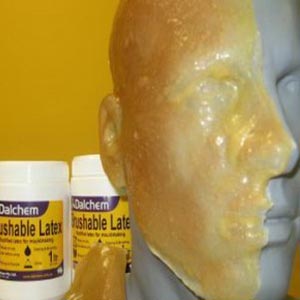You have no items in your shopping cart.
What is Brush Latex?
 Brush Latex is a moulding compound based on pre-vulcanised natural rubber latex. Pre-vulcanised latex is recommended for mould production as it only requires drying to give a strong elastic film. The high solids content and viscosity properties are suited to brush application without the occurrence of runs and sags. For dipping or spray applications, lower viscosity products are available.
Brush Latex is a moulding compound based on pre-vulcanised natural rubber latex. Pre-vulcanised latex is recommended for mould production as it only requires drying to give a strong elastic film. The high solids content and viscosity properties are suited to brush application without the occurrence of runs and sags. For dipping or spray applications, lower viscosity products are available.
Brush latex films, characteristically exhibit low shrinkage rates and fast drying times. Intricate models can be reproduced in exact detail and moulding latex will not separate on standing.
Moulding Production
Brush latex may be used to make moulds from masters (originals) made from various materials such as plaster, clay, glass and concrete.
Here are some instructions on how to make your mould with Brush Latex:
1. Plaster or clay masters should be coated with 2 – 3 applications of shellac or lacquer and thoroughly dried before applying latex. Ensure the masters are clean, dry and free of grease or oil. Except for plaster models, masters may be washed in a solution of dishwashing liquid and water and dried before latex application.
2. Fasten the master to a firm non-porous substrate so that the entire piece can be moved without handling the coated areas. The latex compound may be used as an adhesive by pouring a small quantity onto the support, positioning the model and allowing the assembly to dry.
3. Application of Latex- Brushes used to apply moulding latex should be rinsed in a solution of soap and water both before and after use. This aids cleaning of the applicators and prolongs their use. When applying brush latex, care must be taken to eliminate all air bubbles in the first coat. This will ensure that the detail is accurately reproduced.
4. If a thinner viscosity is required for the first coat, the brush latex may be diluted with a small amount of distilled water. Brush from the top of the model to the bottom and continue out from the base to a distance of approximately 4 cm on the supporting substrate. Apply the overlap for every coat of latex, not just the first. When dry the excess film provides a useful handle in casting operations.
5. The first coat should be dried at room temperature (23 – 25 deg C) in order to minimise lifting from the master. Once the first coat is completely dry to touch subsequent coats may be applied. Drying between coats may be carried out at room temperature. To speed up the process the drying temperature can be increased up to a maximum of 50 deg C either in an oven or by fan heater. If no heat is available, directing a current of air across the surface of the model at room temperature will speed the drying.
Note: Do not use excessive heat as this may:
• Promote shrinkage
• Cause cracking
• Trap moisture in the film
• Lead to low tensile strength
• Cause delamination between layers


